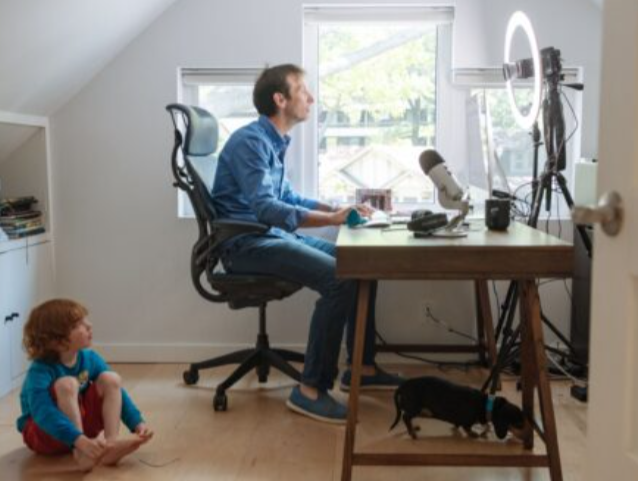The pandemic took a toll on the careers of many working mothers. A rush back to the office is shaping up to be just as damaging.
The lack of child care and in-person schooling that has pushed millions of women out of the workforce in the U.S. since March 2020 has only gotten worse. Though businesses including Microsoft Corp., Amazon.com Inc. and Netflix Inc. responded with backup day care and emergency leave, much of that was temporary and is coming to an end. The $53 billion in federal rescue funds to keep day-care centers running and to reopen shuttered care was a stopgap.
Many businesses recognize the conundrum for working parents, which comes as they are struggling to find new workers and keep existing employees. Even as Goldman Sachs Group Inc. barreled ahead this week to get workers in the office, Citigroup Inc. is saying that most of its employees can have hybrid arrangements. Companies such as International Business Machines Corp. are talking about waiting until September for many to come back.
Goldman Sachs Group brought thousands of employees back to the office across the U.S. for the first time in more than a year.
But even working at home requires someone to watch the kids and the return to office has meant a spike in demand, while the supply of slots at day-care centers, camps and other programs still remains well below pre-pandemic levels. For many families, the only immediate solution is to cobble together a part- time schedule, or in two-parent households for one of them—often the mom—to drop out of the workforce for now.
Kelly Brinkman of Prairie Ronde, Louisiana, is one who left her job—involuntarily. Brinkman worked for a home health and hospice agency, which decided in March to phase out remote work. She was given less than two weeks to return and couldn’t find care for her three kids, so she was fired. Though she’d like to find another job, child care would be more expensive than what she would make.
“I gave up because there’s just no point,” Brinkman said.
While finding affordable child care in the U.S. was difficult before the pandemic, several factors are making returning to the workplace now especially tough for parents. First, young children are still not eligible for vaccination, so returning workers may be concerned about transmitting the virus to them, even if the parents are inoculated. Second, good intentions and emergency care by companies are a Band-Aid, which doesn’t give parents confidence about going back to the office on a regular basis. And third, it’s even harder than it used to be to find good care.
“For parents, it’s an uncertain world,” said Ellen Galinsky, president and co-founder of the Families and
Work Institute.
Read More: Employees Are Quitting Instead of Giving Up Working From Home
The ramifications are global. A paper this month from researchers at Northwestern University, the University of California San Diego and Mannheim University tracked the devastation of women’s careers during the pandemic in the U.S., Canada, Germany, the Netherlands, Spain and the U.K. They found the same pattern of women dropping out to care for children as men continued to work. In the U.S., 1.8 million fewer women were employed in May 2021 compared to the previous peak in February 2020, the last measure before most U.S. offices were shuttered.
“The bounce-back for women, particularly mothers with child-care responsibilities, has been way slower than anyone has anticipated,” said Titan Alon, an assistant professor in the department of economics at UC San Diego and one of the authors of the paper.
One issue is finding enough people to staff day-care centers. Angela Garcia has three empty classrooms among her two Toy Box Early Learning and Childcare Centers in Las Cruces, New Mexico. She has a waiting list of 40 to 50 families that would fill those rooms if she could find staff to hire, she said. Making it worse, about 20% of the more than 700 centers in New Mexico closed during the pandemic.
“I don’t work in an industry where I can say: Alexa, change the diaper,” said Garcia, who is also president of the New Mexico Child Care and Education Association.
Nationally, the estimate is that more than 30% of child care centers and 25% of in-home family day care closed during the pandemic, according to Child Care Aware of America, an organization that advocates for access to affordable child care. Staff turnover was high even before Covid, especially with such jobs paying only an average of $11.65 an hour. A Care.com survey this month found that 72% of parents are saying child care is more expensive and 46% are saying it’s more difficult to find.
For now, many companies seem to be waiting for September for any large-scale return to office and are allowing current work solutions to remain in place, said John Dooney, human resources adviser at the Society for Human Resource Management. But for those that are requiring workers to come back already, parents are making tough decisions that often penalize women.
Fired for Not Returning
In late March, Brinkman, 27, received an email from her employer, a home health and hospice agency in Louisiana, saying that remote work was being phased out and employees would be required to come back in three waves. Brinkman was scheduled to return in less than two weeks. As she knew she wasn’t going to be able to secure child care accommodations for her three children, ages 8, 5 and 2, with such short notice, she asked whether she could work from home for two extra weeks, coming back in the last wave. The company said no.
When Brinkman called her supervisor to explain the situation, she was told she could take that first day off. Brinkman told them she didn’t want to take time off and would still clock in, just not in person. What was supposed to be her first day back in the office, Brinkman logged on to work remotely. She was immediately contacted by HR and fired the next day.
After working remotely for a full year, Brinkman still can’t grasp why she wasn’t allowed to work from home for a few extra weeks. “I don’t understand why the lack of empathy is needed in a pandemic, when we still get the job done,” she said.
Mom Quit So Dad Could Go to the Office
Bart Egnal, CEO of the Humphrey Group, a leadership training company, is happy to be going back to the office.

Bart Egnal works from his home office in Toronto with his 5 year old son and dog, Eggroll. Photographer Galit Rodan/Bloomberg
“I have three young children,” Egnal, 41, said. “I try and get in a day week, I would say, just for some sanity. It makes me feel a bit better; it’s a productive work environment for me.”
With children ages 9, 5 and 2, Egnal says working from his Toronto home meant constant interruptions. He and his wife decided at the beginning of the year he’d go back into the office and she’d give up her teaching job to care for their kids.
“She—we—made that decision,” Egnal said.
Running Out of Options
While Angelica Marie Acosta Torres’s employer, a Seattle-area law firm, is still allowing remote work, she’s already anxious about the inevitable call back into the office.

Angelica Marie Acosta Torres works from her home in Auburn. Photographer: Chona Kasinger/Bloomberg
Unable to juggle homeschooling her three kids and working, Acosta Torres took three months of paid leave through a federal pandemic relief program. When that expired she went back to work. She’s since struggled with child care, and feels like she is running out of options.
Her husband works long hours back in the office, and thus has limited ability to help at home. She’s hoping that by September her older kids will be able to go back to school full time. But she has another child on the way, and is worried about finding and affording daycare.
“I’m obviously still very much stuck,” said Acosta Torres, who says she’s been trying to solve the child care paradox for the 15 years she has been a parent.
“I’m glad we’re finally talking about child care. But we should have been talking about it a long time ago,” she said. “This is a serious thing that affects women and their ability to excel. And I don’t think it should.”
By Carolina Gonzalez, Julia Fanzeres and Jeff Green
This article was originally published here by Insurance Journal. To learn more about homeowner’s insurance contact: Tague Insurance.
Tague Insurance Agency is an independently owned and locally operated insurance agency in Vista, California. We help people across the state find affordable and reliable insurance products from a variety of trusted carriers. As an independent agency, we can help you find the perfect combination of coverage and price to fit your unique needs.
What Does Independent Mean?
“Independent” means we’re not tied to any one insurance carrier. In other words, we can research rates
and coverage options from several top insurance companies to find the best policies for you. We do the
shopping and comparing to save you time and money!
How to Get in Touch
We invite you to submit a free online quote request or call us at 760-729-1143 to review coverage options for auto, home, life, health, business, and more. We provide free, no hassle and no obligation insurance quotes to help you make an informed decision.




